Grow Pole Beans with This Easy Trellis System
Pole beans are one of our favorite vegetables. We share how to grow pole beans, our easy trellis system, favorite varieties, companion plants, and fertilizing tips.
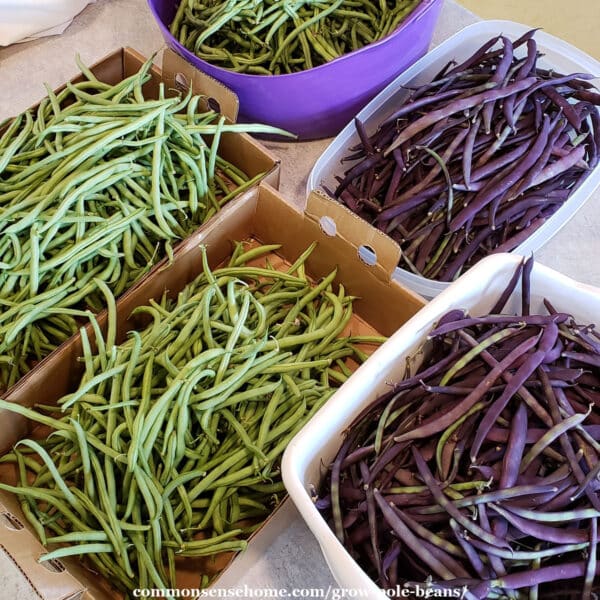
We grow pole beans for fresh eating and preserving, plus extra to swap with the neighbors. Once the season gets rolling, our vines produce until frost. We also save some beans for seed each year.
How to Grow Pole Beans
- Grow pole beans in a garden bed or container. Full sun is best, but plants will tolerate light shade. Best soil pH is 6.5 -7.5 (neutral soil).
- Plant outside, once the soil temperature reaches 60°F (16ºC). They can be sprouted inside to get a jump start, but beans don't transplant well.
- Plant pole bean seeds 1 inch deep (2.5 cm)
- Plant spacing – For poles or pyramids, try 4 plants per hill/pole with hills around 18 inches apart. For trellises, place seeds 3″ (7.5 cm) apart.
- Space rows 3-4 feet apart so you have room for picking. Do not be fooled by the tiny size of the seeds! When properly cared for, these plants will get huge. We plant in a double row, that is, one row on each side of the trellis.
- Pole bean seeds should germinate in 7-10 days
- Watering Needs: Plant in well drained soil. Soil should be damp (but never soggy) at planting. They need about one inch of water per week during the growing season. If the plants get too dry, they'll stop making beans.
- Harvest pole beans every 2-3 days.
In the video below, my son is planting our 2014 crop of pole beans.
What's the Best Pole Bean Trellis?
I've seen many beautiful and ingenious trellises specifically built for pole beans or improvised out of materials at hand. Some bean trellis options include:
- Nylon trellis netting – our favorite
- Wire fencing – pole beans can create a nice seasonal privacy screen
- Cattle panels and recycled pallets – You can see these being used as tomato trellises here, but they also work for beans.
- Sticks or bamboo poles – use these arranged down a row or as a tepee to act as a bean supports.
- String trellis – String trellises are typically secured at top and bottom in a tepee configuration. Beans may require some encouragement to climb the strings. If you use biodegradable string, you can compost them with your bean stalks at the end of the season.
- Arbors – Who says arbors have to grow only grapes or flowers? Bean blossoms are pretty, too, plus you get tasty veggies.
- The VineSpine™ folding metal trellis – these metal grids fold flat for storage.
Whatever bean trellis you choose, make sure it is well-secured so it doesn't tip over in strong winds. The neighbor's lost their bean tepee in a storm, just when the beans were starting to mature. It was a big mess, and the beans never fully recovered.
We use nylon trellis netting supported with metal fence posts and wooden cross pieces on top.
3 Reasons I Like Trellis Netting as a Pole Bean Trellis
- Wide openings are easy to reach through for harvesting. You can harvest from both sides instead of trying to reach inside a pyramid trellis.
- Durable – My trellis has lasted for many seasons (except when I cut it with clippers – whoops). You might see some of the patches in the photos. Most of my netting is over 5 years old.
- They store in a small amount of space. The netting itself can be stuffed in a small baggie, while the support posts stack in a corner of the greenhouse.
Steps to Set Up Your Bean Trellis Netting
Place 6- 7 foot tall metal fence posts at five foot intervals along the row. Secure trellis netting to each post in at least four spots. I use strips of old sweatpants for this. You could use twine or whatever you have on hand.
To make weeding easy, we place wet newspaper between the double rows and cover it with mulch. Then we hang the trellis above the mulch. Make sure to get the trellis up while the beans are still small so they don't get tangled.
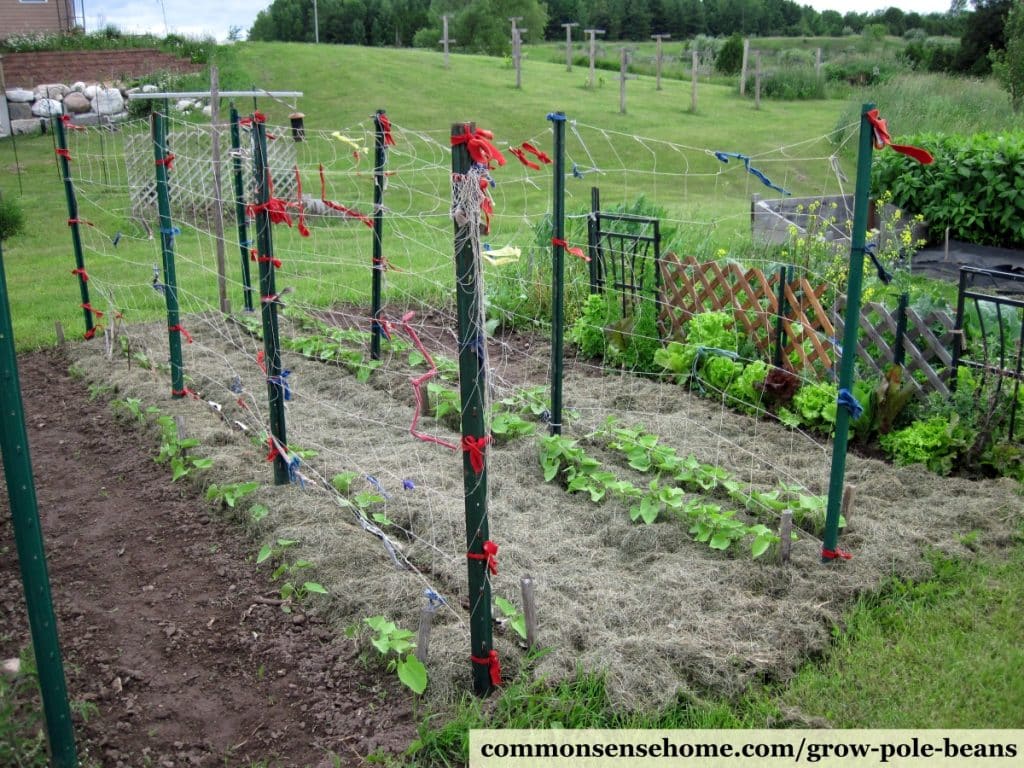
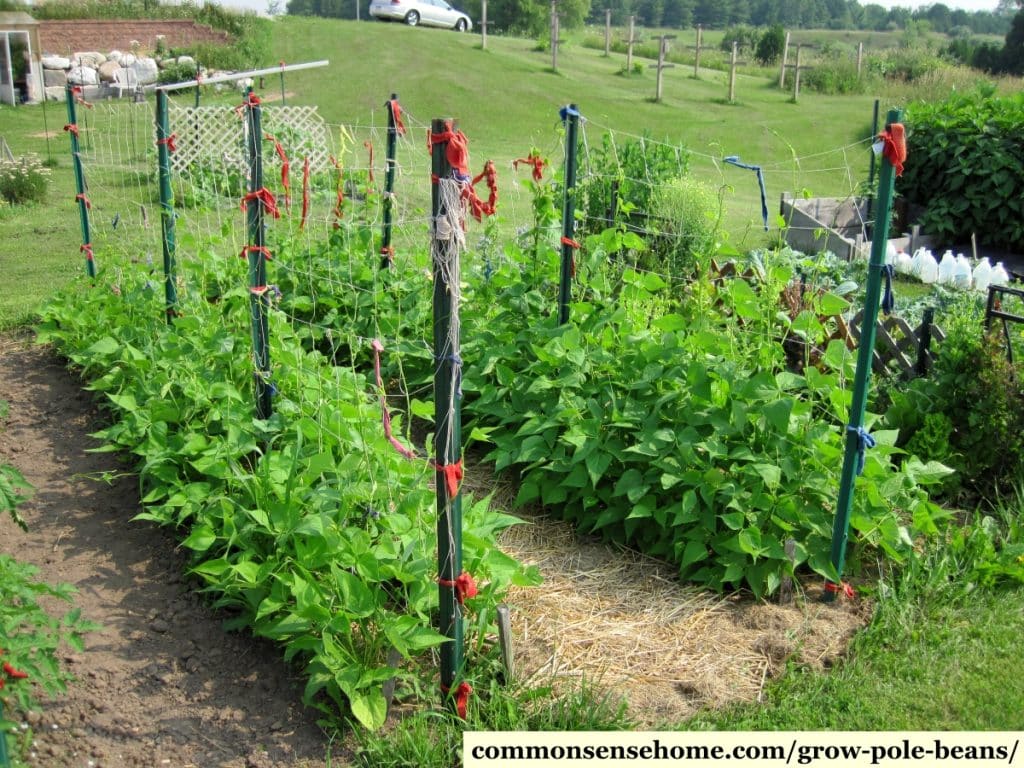
I plant the beans on each side of the trellis, so it is loaded quite heavily as the season goes on. To help support the bean plants, I tie a wooden cross support to the top of the fence posts. I use 2″x2″ or 1″x2″ pieces around 6 feet long. We tether the trellis netting to it at regular intervals.
The beans should shoot right up the trellis without much fuss. Once in a while you may need to guide them in the right direction.
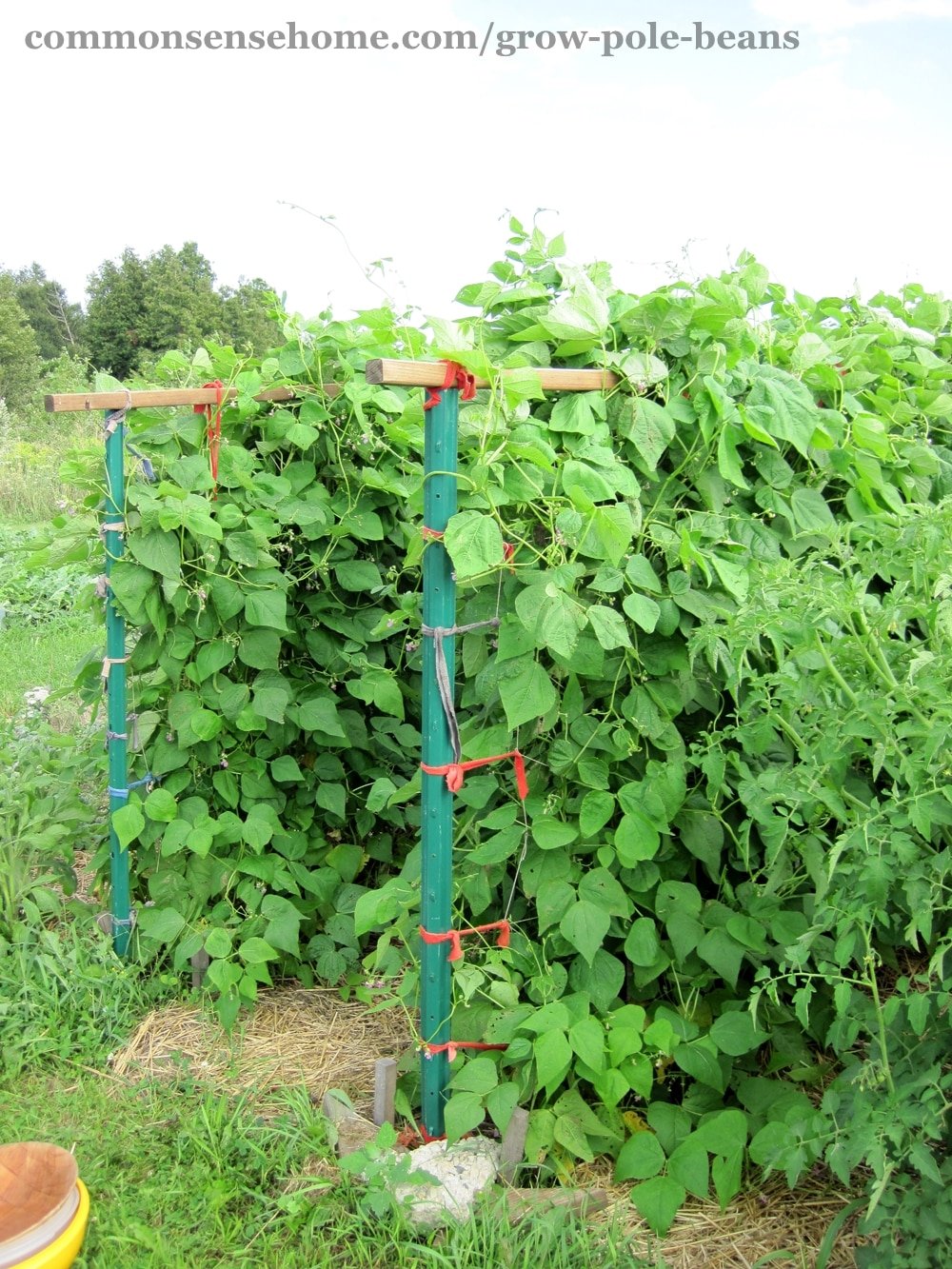
Pole Bean Companion Plants
The Vegetable Gardener's Bible recommends these companion plants:
Good pole bean companion plants: Pole beans like carrots, cauliflower, chard, corn, cucumbers, eggplants, marigolds, peas, potatoes, rosemary and strawberries
Bad companion plants (avoid planting pole beans near these plants): Basil, beets, cabbage, fennel, kohlrabi, onion family, radish, sunflower
I regularly have sunflowers near my pole beans and haven't seen any problems with it. Sometimes the beans climb right up the sunflowers. Beans and radish are both commonly attacked by flea beetles, so I could see that keeping them apart would make sense.
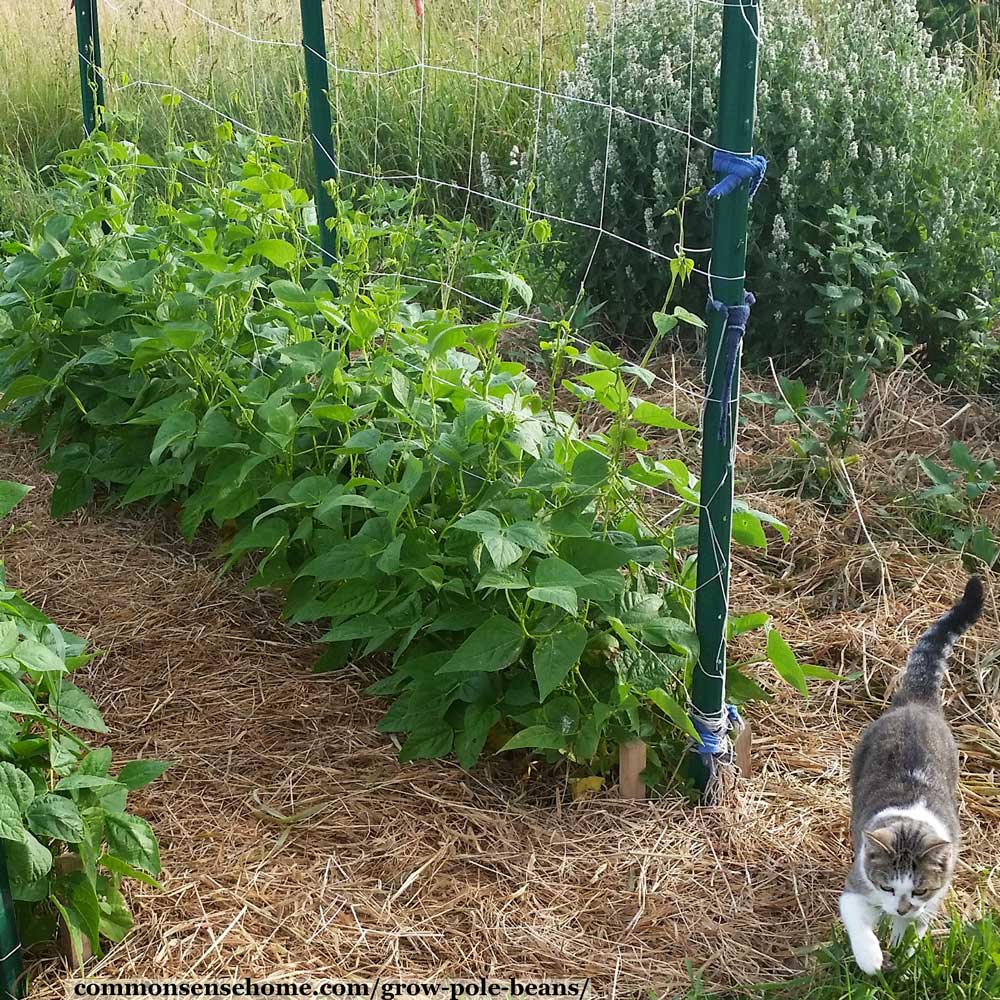
Pole Bean Fertilizer – Yes or No?
Do I Need to Fertilize my Beans? No! Do not overfertilize your beans! Too much nitrogen (like fresh manure or high nitrogen fertilizers) will give you lush leaves and very few beans.
Beans are modest feeders, and like all legumes, they can create their own nitrogen from the air. (Nitrogen is the “N” in NPK fertilizers.) The trick is that it's not the beans that make the nitrogen, it's the bacteria that live on their roots.
Without nitrogen fixing bacteria in the soil, the bacteria can't colonize the plant roots, and your beans will struggle.
If you've been successfully growing legumes in your garden, then you probably have nitrogen fixing bacteria in your soil. If you've never grown beans or haven't had success with beans, try a legume inoculant when you plant.
Legume inoculant comes as a powder. You use it coat your seeds with before planting, or add it to the planting trench. Other than that, add a little well aged compost or manure in your planting area and you should be good to go.
Bush Beans versus Pole Beans
There's nothing wrong with bush beans, but we find pole beans work better for us. I still grow some bush shell beans that I harvest once, at the end of the season, for dried beans.
For my main crop, I switched to pole beans years ago and haven't looked back. Here are 3 reasons I like pole beans better than bush beans.
Pole beans:
- Are easier to pick. It's so nice to be able to pick beans standing upright! As I work down a row, I work up and down the plants so I get to shift positions.
- Pole beans stay cleaner. When your garden is wet, bush beans often end up with the beans covered in muck. With pole beans, the bulk of the crop is well above mud level.
- Are less bothered by pests and diseases. Since the beans grow up away from the ground, they get bothered less by ground pests, like slugs. Training plants up improves air flow, which reduces mildew and fungal diseases.
Sure, it takes some time to put up a trellis and take it down at the end of the season. To me, the benefits far outweigh the small amount of extra work.
What are the Best Pole Bean Varieties to Grow?
My personal favorite are Emerite pole beans, which are a French heirloom. These beans are great over a range of sizes. They have to be really overgrown to get tough and chewy. If a few beans are missed during one picking, odds are they will still be good at the next.
I got my seeds from my mom, who got them from my uncle, and I've been saving seeds each year.
If you want to save seeds for replanting, see “How to Save Green Bean Seeds“.
I've also read good things about Fortex and Blue Lake, but haven't tried them yet. (Kentucky Blue is a cross between Blue Lake and Kentucky Wonder.)
If you'd like to try purple pole beans, I recommend Purple Podded Pole Beans. The yield isn't quite as high as the Emerites, but they are a solid producer. The difference in color makes them easier to spot while picking.
The Vegetable Gardener's Bible recommends Gold Marie as a wax pole bean. I had pretty good yields with Sultan's Crescent Golden Green Beans.
You can use the list below to buy these bean varieties online:
These varieties are all snap bean species (Phaseolus vulgaris). Other species of beans that grow well on trellises include:
- Yard long beans (Vigna unguiculata ssp. sesquipedalis)
- Runner beans (Phaseolus coccineus)
You can grow these different bean species near each other and they will not cross pollinate. This makes it easy to save seed.
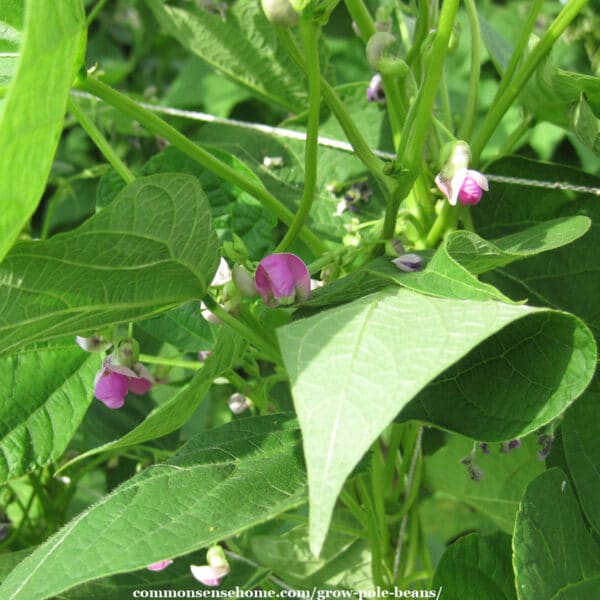
How Often do I Need to Pick My Beans?
Pick pole beans every 2-3 days to keep them producing. If you leave mature beans on the vine too long, the plant thinks that its job is done. It will stop setting fruit.
See “How to Store Green Beans (for Short Term or Long Term)” for tips on preserving your harvest.
Do I Need Bees to Pollinate my Pole Beans?
No. Beans are usually self-pollinating – but bees are always welcome and may increase yields.
To recap – plant pole beans in warm soil with legume inoculant. Don't use too much fertilizer. Get your trellis up while the beans are small. Water deeply, and pick beans every 2-3 days.
I hope you found this post helpful. If you have any bean growing tips or questions, leave a comment and share them below. If you found the post useful, share it with your gardening friends.
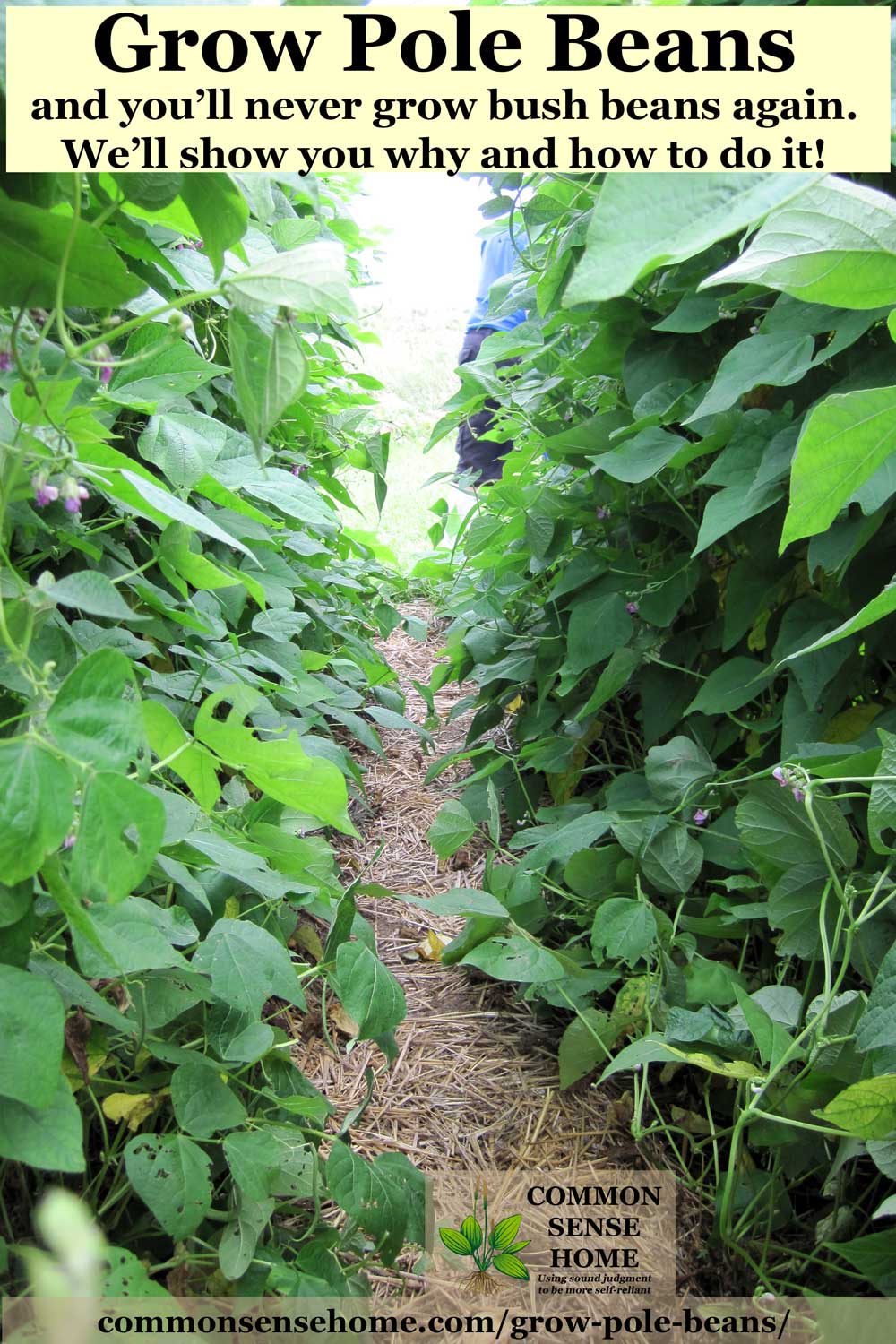

This article is written by Laurie Neverman. Laurie and her family have 35 acres in northeast Wisconsin where they grow dozens of varieties of fruiting trees, shrubs, brambles, and vines, along with an extensive annual garden. Along with her passion for growing nutrient dense food, she also enjoys ancient history, adorable ducks, and lifelong learning.
Originally published in 2014, last updated in 2023.

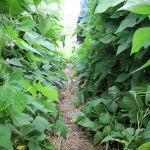
Would a wooden railing/bannister about 36″ with 2″ vertical balusters spaced about 4″ work for beans grown in a container? This is on a 2nd-floor deck with lots of sun. Would plastic netting on this be a great advantage?
36″ is a little short for a trellis. If you can’t go up at least 5 feet up (maybe with a trellis mounted on the side of the building?), it’s probably best to stick to bush beans.
Talk pole beans then put pic of green bush beans??????
I don’t understand the comment. All the photos in the post are pole beans at various stages of growth.
Strange that pole beans like carrots but not fennel!
Thanks for this page!!
I suspect it has to do with fennel needing more sun to form a good sized bulb, whereas carrots can tolerate a bit more shade.
HI! I have been successfully growing the Emerite beans with your method for three years now – Great! I also save my beans every year and they grow wonderfully.
My question: the mulch you use in your pictures – what is it exactly? We have tried “straw” – I’ve gone to two different feed stores and asked for seedless straw, but it always must have seeds because I have hay sprouting all over the place.
Any helpful tips?
Thanks!
We get straw from neighbors, usually oat straw. Real straw should be tan in color and have few seeds, since it’s the stalks left after the seed heads have been harvested. Around here, some garden centers stock straw, but sometimes they carry “marsh hay” (marginal hay from rough areas) and sell it as straw when they can’t get regular straw.
Any greens that spout from real straw are typically oats, wheat or rice, and are easily pulled. If you get a lot of weeding greens coming up from your “straw”, it’s probably overripe hay being sold as straw.
You might try tree trimmings from landscape companies that mulch the tops of trees they remove. Those will work okay as long as they are not dug in and rot own slowly on the soil surface. If dug in, they can bind up nitrogen in the soil during decomposition.
There are also alternative mulches like coco hulls, but these tend to be expensive for larger areas.
Thank you for this very informative guide for pole beans. I have been planting ‘Emerite’ pole beans from Renee’s Garden in CA for several years and have never been disappointed with the results. They out perform all others so much so that the neighbours must have been tired seeing me come with bags of beans every few days. I’ve never had much luck with freezing beans, they always seem bland and chewy when cooked. I will try your method and see if that works.
Happy Gardening everyone…
Frozen beans will never be quite the same as fresh, because the freezing process damages the cell structure. they are less mushy than canned beans, but lose that snappy texture.
Glad to hear from another Emerite fan.
I’m planting pole beans for the first time in a self watering planter with a trellis. The beans have shot up but haven’t attached themselves to the trellis. Should I attach them in some way or wait a bit longer? How would you suggest attaching them? Thanks!
You may need to guide them around the trellis as they grow. If they still refuse to latch on, you can tie them on with soft strips of cloth until they start climbing more on their own. We make strips from old clothing, like sweatpants or t-shirts.
This is our first year doing pole beans. This post is very helpful.
I was wondering I have a dog kennel that’s up but I’m not using it can I plant pole beans on it I’ve never planted Bean’s before I really would like to
When you say “dog kennel”, I assume you mean a small fenced area? Assuming there’s no fresh dog poop right where you want to plant your beans, that should be fine. Aged dog poop mixed into the soil should be fine, as long as you make sure that the beans you harvest are not in direct contact with that soil. (Guessing at one point the kennel had a dog in it.)
How do you clean your netting aftereverything is picked. How do you remove the old vines to prep it for the next year.
I use a set of hand clippers to carefully clip away the dead vines while keeping the netting intact. It’s best to do this after the foliage has died back but while the netting is still hanging. I tried to clean it one year after taking the netting down, and that was a total mess. After the vines are removed, I bundle the netting and tie it with a strip of cloth so that it stays together and doesn’t get tangled up with other netting. I keep all my netting bundles in a bag together. I don’t wash them between seasons because I don’t tend to have many disease issues, but if you wanted to, I’d put them in a pillowcase to wash. Usually I get them up early in the season so that they get rain, fresh air and sunshine baked before they get covered in vines.
Love the tips!! I live in southern Minnesota and use Blue Lake pole beans and have had wonderful results except for this year…. We ran out of rabbit fencing, and they ate off my plants down to the nub before we were able to get more and get it put up. We JUST picked our first harvest of beans 2 days ago!
Glad you finally got a harvest! Naughty bunnies. We grew Blue Lake one year, but I find that the Emerite are more forgiving if the beans get a little larger before picking. They have to get really overgrown before they get tough and stringy.
great tutorial! thank you so much for the information. very well articulated and the photos were a tremendous help, too. your time and effort are appreciated by us old bean lovers. God bless for sharing.
s.o. faulkner ps i live in n ms delta. rare is a frost between march and middle of november. the dirt is black better than 5ft down. it is no tellin how high beans would grow!
Thank you for your kind words, and best to go with the extra tall trellis. 😉
I would like to know if you are supose to pinch the ends of the bean vines so they will bunch out or do you just let them run and fall over?
I don’t do either. I point the ends of the beans up the trellis so they grow up, and when they reach the top I point them one direction or another along the trellis so they keep growing supported by the trellis.
Sorry if this question has already been addressed, but I was wondering if the trellis netting can be used again. Is it difficult to remove the bean plants once they’ve died or are done producing so that you can save your nylon trellis?
I’ve reused my nylon trellis for many years. You do need to be careful not to clip the trellis as you remove the spent vines. I suppose you could take down the trellis vines and all and wait for the vines to dry and snap off, but I usually clip the bean vines clear after the first hard frost.
We have a lot of wind (20 MPH or greater) which has made trellising a challenge. But I am not ready to give up on pole beans (for the same reasons you listed). Do you have a lot of wind? How far down into the soil did you sink your poles?
We have a lot of wind here, too – windiest area of Wisconsin. We use 6-7 foot tall fence posts and drive them in about a foot. Most of the time we use U-posts, but you have to be careful pulling them at the end of the season, because they’ve been making them cheaper and they like to bend now. (The difference between my old u-posts and the new ones is terrible.) T-posts will hold up better to repeated use without bending.
Thank you! I need to sink my posts farther. we live in western MN, thus receiving channeling class 4-5 winds from Canada and down through the Red River Valley. During the summer the south winds also channel through the yard. It is interesting to figure out how the wind wraps around the grove and buildings. I should be paying more attention to the snow drifts. The drifts are trying to tell me something.
We’re along the Niagara Escarpment, so it’s around class 4 here. One of the first things we planted when we moved in was wind break trees to the west and north. It’s slowly starting to help.
Our grove is mostly 60+ year old ash, most of which are starting to die. I have an opportunity to improve the wind flow and make more room for an orchard. Your comment reminded me this needs to be on my planning list now and planting by next year.
Thanks to your article I tried pole beans (Emerite) on the same kind of trellis and had great success (although my first planting never came up – due to the very cold and wet spring here in Colorado). The second planting came up well – but we didn’t get a crop until August. We have had so many beans we haven’t been able to keep up with them! And many have grown too big…pods are tough. My question is: can we remove these big beans from the pod to eat in other ways? Any recipes or suggestions? Also, you mentioned that my bean garden would be too small for saving seed (I planted 2 rows, 10 feet long each) for a good gene pool? What does this mean? I really wanted to save some for next year. Thank you for giving the great encouragement and knowledge for a successful garden – even in Colorado!
Hi Trina.
Glad the beans worked out well. If the beans are fully mature, you can use them like other dried beans, in soups, refried beans or other recipes. Beans that are large but not dried could also be cooked as a side dish with a little butter and salt, or used in veggie soups or stews.
Ideally, to maintain a stable gene pool, it’s best to have at least 30 plants of a particular species. This allows a certain amount of diversity. As I mentioned in the post, we simply mark the end of one row (about 2 feet) and allow the beans to fully mature on the vine. We may or may not have the full 30 plants each year. I don’t worry about it too much, but if I were selling the seed, I would watch it more closely.
EZ FREEZIN
When I pick my purple pole beans I just cut the stems off, put them standing up in a long enough freezer bag like a bag of pencils, suck the air out, twist the top of the bag, tie with a wire twist tie, loop and twist tie again to keep the vacuum and stick tha bag in the freezer. Straight from the vines to the freezer. No blanching!! Then I can open a bag and take out how ever many I need at that time. When they are still frozen, snap the pods into pieces in between each bean instead of cutting with a knife for making soup. This way no pieces of beans fall out when you’re cooking them. Or I pile a bunch of whole ones, frozen into the steamer for a side vegetable. Eat them whole or cut them up after they’re steamed whole.
Hello, I’m relatively new to growing really any type of vegetable. My husband and I built a raised garden bed last year and surrounded it up to 5.5 ft to prevent our large deer population from helping themselves to only be outsmarted by a bunch of scavenging squirrels. I know tomatoes are susceptible to squirrel scavengers, are pole beans a similar story?
It depends on how hungry the squirrels are. They are pretty opportunistic, and will eat just about anything. The good news is that squirrels taste quite a bit like chicken (dark meat). Cats may also help keep the squirrel numbers in check.
At the end of the season I always have lots of dried beans left on the plants. They taste much better than store bought. Great for bean soups or minestrone.
Just how far do beets need to be away from pole beans? I really want to add this colorful
veggie to my diet and want the best success advice, thank you.
I usually try to give beans at least three feet between them and other plants. They’ll spread about a foot wide, even with a trellis, and you need some room to walk to be able to pick.
Hi, thanks for the great info. I notice that you have tomatoes next to the beans – do you use the same setup with the trellis netting and cross supports for those as well? Seems like it might work well…..
Thanks!
The tomatoes tend to get much heavier than the beans, so I use a different system that’s outlined in the 5+ Terrific Tomato Trellises post.
this link is not working
Which link?
This may have an obvious answer, but I am so very new to gardening…and have been labeled as having the “black thumb” of the family. I would love to grow beans and was curious to know if you think that my chain length fence could serve as a trellis for them or would you advise that I build one instead?
I you have good soil by your fence and agreeable neighbors (if it’s on a lot line), I don’t see any problem with using the fence as a trellis.
how far away from fence would you plant? Thanks.
I don’t measure exactly, I just aim to have the rows snug next to each other with the fence between. Dirt gets kicked up around the furrow, so the bean rows end up roughly 10 inches apart (a hand’s length). If you look in the planting video you can see the naked furrows in the soil.
Hi Laurie, we have always grown bush beans but the rabbits got most of them this year 🙁 I will have to try the pole beans next year. Your garden looks so compact and efficient, would you do a post about how you plan and lay it out?
I’m sorry to say that if they are hungry, ferocious bunnies will happily eat pole beans, too.
Looks may be deceiving. This is only one garden bed out of nine total, covering the better part of an acre on two sides of our house. You can see it from space. 🙂 (Only partly joking – you can see it using Google Earth.)
I do have a post called Simple Record Keeping for the Garden, where I talk about how I keep track of things. You can also view a virtual garden tour from July 2014 on our youtube channel.
I have an experiment going this year. I planted Dean’s Purple Podded Pole beans around my tomato plants. The beans have grown up the tomato cages and plants, fallen over, then back up. They are producing fantastically! I’m harvesting enough that we have them as a generous side every other day and I am preserving them for winter. The purple beans are easy to find amid the tomato and bean foliage and the entire garden looks lush and full.
Your tomatoes are still getting enough light and air circulation with the beans sharing the cages? Maybe you are in a warmer climate than I am.
Hi Laurie,
Thank you for another great gardening article. I learn something new every time I read one of your articles. Your comment about following the brassicas with beans was much appreciated as well. We try to rotate too, and knowing what to plant in that spot the following year is as important as knowing companion planting for a sustainable garden to us. I don’t know how you have the time to do all the writing you do, but I for one really appreciate it! 😉
Aw, thanks, Deb. It’s a struggle sometimes to juggle everything, but hopefully it’s a help to people.
This is an awesome tutorial. Great information. Everything I need to know. Thank you!
Thanks for taking time to comment, Christina. Happy bean growing. 🙂
Our pole bean set up is a little different. We made ours permanent. We sunk 2 4X4x8 two feet in the ground 8 feet apart. We then used 4x4x8 on the ground about 6 inches apart and closed off the ends with pieces of 2x4s to make a semi raised bed. Between the two upright 4x4s we ran 5 foot tall chicken wire. After the growing season we take garden shears and clip off the vines that grew between the chicken wire to clean it all up. Very little weeding and very easy and quick to water because all we have to do is fill the raised bed with about an inch of water and then let it soak in. Our beans usually grow up to the top of the chicken wire and then start back down the other side. Our bed runs North and South so both sides get half a day of sunshine. Since we live in NC we get to pick beans most of the summer till the plant starts to die off. We are thinking of adding more of the raised beds to increase our production since it takes up little space. I always dehydrate and use quart jars with oxygen absorbers to preserve them.
This sound like a nice setup. I like to rotate my beans around the garden to help enrich the soil. They are great to have in an area prior to planting corn or brassicas, which like plenty of nitrogen in the soil.
I have always planted bush beans, and stayed away from pole because when I was a young wife we had planted a garden using pole beans, my husband liked the rather big, so we waited to harvest, I picked, I cleaned I blanched, I froze…..then we picked strings out of our moths! I like my bush beans when they are maybe half grown. Do pole beans always have strings? If you pick them young can you avoid that?
One of the reasons Emerite is my favorite variety to date is that they have to get hugely overgrown to get stringy. They are much more forgiving than some of the other varieties I tried years ago. I should have made notes about which varieties I tried, but back then I wasn’t blogging so I just stopped growing them and forgot the names. The Purple Podded Pole Beans get stringy when they get large, so I always try to pick before they reach full growth. When processing, I usually snap the beans by hand instead of cutting, because if they don’t snap cleanly I can see they they are stringy. When cutting with a sharp knife, you don’t notice the strings – until it’s too late.
Are your bean seeds organic & non gmo? I have googled and couldn’t find any, lol. I love green beans are my fav too. Yumm. Yiur garden is amazing!!! So jealous.
There are no genetically modified bean seeds yet, to the best of my knowledge. The Emerite seed source linked in the post(Renee’s Garden Seeds) states on their website”
My seeds have been cultivated by me for years, but Renee’s looks like they try and source responsibly, too.
Thanks for the kind words on the garden.
Yes, I did see that. Awesome. I just love your whole set up. Thanks so much. 🙂
Try territorial seed co . My favorites are helda and violet podded stringless.